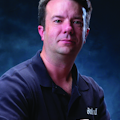When I am looking for column ideas, among the places that I like to turn to are the multitude of firefighter forums on various websites and read what people are posting. If a topic shows up more than once or spans multiple sites, then I assume it to be relevant. This month, I located a topic thread on three different firefighting-specific websites regarding "freezing" of the image on a thermal imager (TI). The responses ranged from "you are simply panning the imager too quickly" to "you need to send that in for service right away as that is a serious problem." Across all of the various responses, more than 15 in total, not a single one accurately identified the issue. This is incredibly troubling to those of us who conduct training, since the phenomenon of image "freezing" has been going on for 10 years now and occurs on every single thermal imager sold in the firefighting market today.
By far, the most common thermal imaging technology available on the market today is microbolometer-based. I will spare you the boring details of a technical explanation; microbolometers offer the benefit of reduced size, increased durability and decreased cost over earlier technologies. One characteristic of microbolometers is their method of calibration. All thermal imagers must calibrate in order to maintain accuracy over time. While older technologies accomplished this feat in different ways, microbolometers accomplish this calibration by closing an internal shutter and calibrating the detector with the shutter closed. Once recalibrated, the shutter will open and the thermal imager will resume normal operation. This is technically known as Non-Uniformity Correction (NUC), but laymen's descriptions can include "shutter firing," "image freezing" or "stuttering". It happens very quickly (usually less than half a second) and will result in a frozen image on the screen while the internal shutter is closed. This NUC will occur automatically every 30 seconds to three minutes, depending on the manufacturer and ambient conditions, and will also occur every time the thermal imager changes gain states.
The earliest microbolometers could not resolve temperatures above 250 degrees Fahrenheit, which limited its desirability as a firefighting tool. Most thermal imagers on the market today can resolve temperatures greater than 1,000°F. This was accomplished through several technological advances, the most notable of which was the multiple gain state.
The detector of your thermal imager is not sensitive enough to detect temperature differences at ambient levels. It prefers the strong input of higher heat levels. The only way to generate an image at ambient levels is to turn up the gain. This high-gain state allows the thermal imager to generate a usable image at low (ambient) heat levels; however, when confronted with much higher heat levels, this gain becomes quickly overloaded and saturates. The solution is to allow the detector to de-tune itself by turning down the gain when confronted with higher temperatures. This low-gain state is pre-defined and allows the thermal imager to resolve much higher temperatures. The thermal imager will switch back and forth between high and low gain states automatically and on its own; however, each and every gain shift will require an NUC. This means that every time you look at fire with your thermal imager, you will notice an NUC as the imager shifts from high gain to low gain; every time you look away from the fire, you will also notice an NUC as the imager shifts from low gain back into high gain. If you look back and forth at a fire and then away from a fire, you will notice a persistently frozen image as the thermal imager switches back and forth between gain states.
If you simply turn your thermal imager on and walk around the firehouse while staring at the screen, at some point in any five-minute window of operation, the picture will momentarily freeze. If you turn on the burner on your kitchen stove, let it get hot and then look at it with your thermal imager, you should again notice the image momentarily freeze as the imager changes gains. The point is this: NUC is a normal part of the operation of your thermal imager and is something that every firefighter should be aware of. Most firefighters do not even notice that this phenomenon occurs. It is subtle, quick and generally infrequent; however, there are times when an NUC leads the firefighter to false assumptions of technology failure, operator failure or worse. Get your imager out and try this. Show this to the other firefighters you are working with. The easiest way to avoid misunderstandings is to train for them.
BRAD HARVEY is the Thermal Imaging Product Manager at Bullard. He is a veteran of public safety as a firefighter, police officer and paramedic and is certified through the Law Enforcement Thermographers' Association (LETA) as a thermal imaging instructor. Harvey has worked as a high-angle rescue instructor and is a certified rescue technician and fire instructor. If you have questions about thermal imaging, you may e-mail him at [email protected].
About the Author
Brad Harvey
BRAD HARVEY is the Thermal Imaging Product Manager at Bullard. He is a veteran of public safety as a firefighter, police officer and paramedic and is certified through the Law Enforcement Thermographers’ Association (LETA) as a thermal imaging instructor. Harvey has worked as a high-angle rescue instructor and is a certified rescue technician and fire instructor. If you have questions about thermal imaging, you may e-mail him at [email protected].
